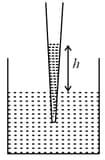EASY
Earn 100
A soap bubble contains two surface layers, what is the excess pressure just inside the first layer when seen from outside the bubble?
(a)
(b)
(c)
(d)
50% studentsanswered this correctly
Important Questions on Properties of Matter
MEDIUM
MEDIUM
EASY
HARD
EASY
MEDIUM
EASY
MEDIUM
EASY

EASY
MEDIUM
HARD
MEDIUM
MEDIUM
EASY
HARD
A water drop of radius is broken into equal droplets. If surface tension of water is , then the gain in surface energy upto first decimal place will be
[Given ]
EASY
HARD
MEDIUM
HARD
If two glass plates have water between them and are separated by very small distance (see figure), it is very difficult to pull them apart. It is because the water in between forms cylindrical surface on the side that gives rise to lower pressure in the water in comparison to atmosphere. If the radius of the cylindrical surface is R and surface tension of water is T then the pressure in water between the plates is lower by:


